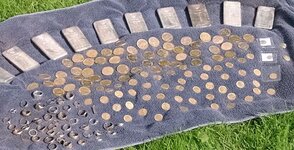Timberwolf
Silver Member
- Sep 12, 2005
- 2,528
- 38
- Detector(s) used
- Eagle II SL90/Eagle Spectrum/TF-900
First of all I should say that I have never found a cache. I am currently working on two locations, but have yet to get on the property and hunt.
My question is for those of you that have found caches. I don't want to know any details of what you found or where. I understand the importance of keeping quiet about recovered treasure.
My question is: How deep was your deepest cache?
A lady who works for Garrett told me that a Garrett Groundhog should detect a cache up to three feet deep.
Can anyone shed any light on my depth question?
Thanks in advance,
Tom
My question is for those of you that have found caches. I don't want to know any details of what you found or where. I understand the importance of keeping quiet about recovered treasure.
My question is: How deep was your deepest cache?
A lady who works for Garrett told me that a Garrett Groundhog should detect a cache up to three feet deep.
Can anyone shed any light on my depth question?
Thanks in advance,
Tom


 ) Deepest was 18" - size of a beer can. I don't have the right equipment for deeper caches. Could luck with getting onto the properties you have been researching.
) Deepest was 18" - size of a beer can. I don't have the right equipment for deeper caches. Could luck with getting onto the properties you have been researching.

 So now after digging so many pull tabs anything rusty coming out of the ground is a treat, because I probably don't know what it is and I can imagine that it is old.
So now after digging so many pull tabs anything rusty coming out of the ground is a treat, because I probably don't know what it is and I can imagine that it is old. 


